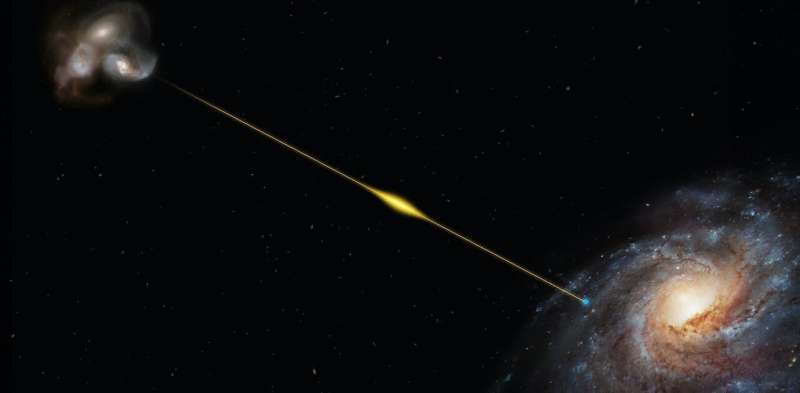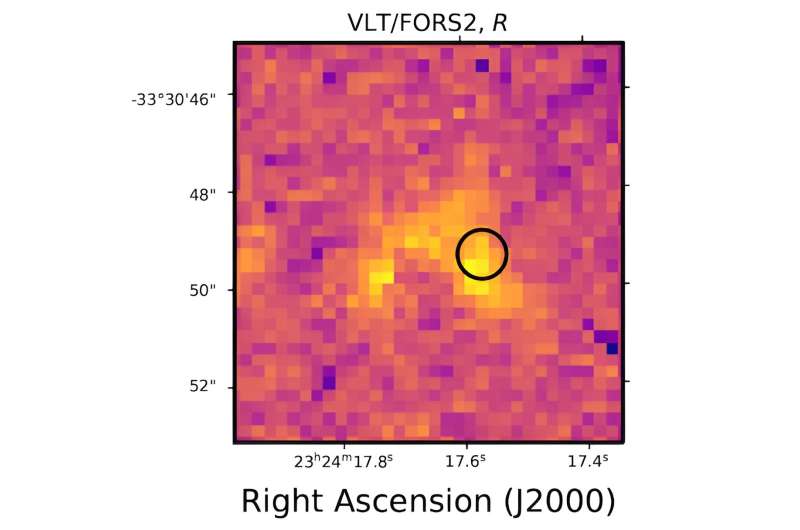This article has been reviewed according to Science X's editorial process and policies. Editors have highlighted the following attributes while ensuring the content's credibility:
fact-checked
peer-reviewed publication
trusted source
written by researcher(s)
proofread
Researchers trace a powerful radio signal to the most distant source yet—a galaxy billions of lightyears away

Every day and night, hundreds of thousands of intense, brief flashes of radiation suddenly flicker on and then off all across the sky. These "fast radio bursts" are invisible to the naked eye, but to a radio telescope many almost outshine everything else in the sky for a few thousandths of a second.
Since the first such burst was spotted in 2006, we have found that nearly all of them come from distant galaxies. Most bursts pass unnoticed, occurring outside the field of view of radio telescopes, and never occur again.
In new research published in Science, we have found the most distant fast radio burst ever detected: an 8-billion-year-old pulse that has been traveling for more than half the lifetime of the universe.
Seizing the opportunity
Astronomers are fascinated by fast radio bursts for two reasons.
The first is that their cause is unknown. The bursts are a trillion times more energetic than the things that look most like them: rotating neutron stars called pulsars, in our own galaxy.
The second reason is that the bursts provide a new tool to study other aspects of the cosmos.
Fast radio bursts let us study the "cosmic web" of matter floating in the space between galaxies. This matter is very hot, diffuse gas and almost invisible, but it subtly slows down fast radio bursts as they pass through it. (This is ordinary matter, the same kind that makes up stars, planets and humans, not the invisible "dark matter" that also lurks throughout the universe.)
The degree to which bursts slow down correlates with the distance they have traveled.
In 2020, analysis of fast radio bursts revealed that the cosmic web actually contains more than half of the normal matter in the universe—which astronomers had previously thought was "missing."
In search of the extreme
More distant and extreme fast radio bursts promise to reveal further secrets about the universe, so astronomers are on the hunt. I lead a team doing just that, using the Australian SKA Pathfinder (ASKAP) radio telescope.
On June 6 2022, our team detected and pinpointed a very bright burst with a high degree of slowing (known officially as "FRB 20220610A"). Our initial calculations suggested it might be the most distant ever found.

However, there was a possibility that the burst was closer than we thought—or that it might come from a distant galaxy too faint to be seen with an optical telescope.
We turned to one of the world's most powerful optical observatories to search for the host galaxy: the Very Large Telescope (VLT) in Chile. The observatory's four telescopes are equipped with cutting-edge cameras and spectrographs that can identify faint host galaxies and study their properties in detail.
At the position pinpointed by ASKAP as the source of the burst, initial images revealed faint smudges of light that looked like a distant galaxy. Analyzing the spectrum of light from the galaxy showed it was strongly "redshifted," meaning the emission from the burst has doubled in wavelength as it stretched out on its journey through the expanding universe.
The redshift had a value just over 1, which shows the burst was emitted more than 8 billion years ago, when the universe was less than half its present age. This confirmed that FRB 20220610A had broken the record for the most distant fast radio burst.
Pushing the limits of the universe
Like Olympic athletes, astronomers (including me) enjoy breaking records. Beyond personal satisfaction, however, this detection can also be used to explore the two fundamental questions about fast radio bursts.
First, the burst has the most energy of any that has been securely pinpointed to a location. It is more energy than our sun puts out in 30 years, and approaches what we believe are fundamental physical limits.
The upper limit on the amount of energy any one fast radio burst can carry may be determined by quantum mechanical effects. At a certain point, the burst's surge of radio photons may meet resistance from a sea of "virtual" electrons and positrons which British physicist Paul Dirac predicted in 1930.
Our discovery also demonstrates the potential for fast radio bursts to study the composition of the distant universe. As we look back in time, we see the structure of galaxies changes a great deal. Bursts in distant galaxies may allow us to study the detailed structure of their hosts.
Delving deeper in the cosmos
We now know that energetic bursts exist in the distant universe. As new and upgraded telescopes join the hunt for fast radio bursts, we are likely to see many more tracked down to their host galaxies.
We are currently building a new fast radio burst search system for ASKAP which will make it five times more sensitive, enabling us to push the frontier of our research further out into the universe.
And in the future, ultra-sensitive radio telescopes such as the Square Kilometer Array (SKA) will be able to detect bursts at ever greater distances. These detections will be used to map the structure of the universe and resolve the tale of a modern astronomical mystery.
More information: S. D. Ryder et al, A luminous fast radio burst that probes the Universe at redshift 1, Science (2023). DOI: 10.1126/science.adf2678
Journal information: Science
Provided by The Conversation
This article is republished from The Conversation under a Creative Commons license. Read the original article.![]()





















